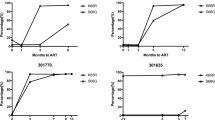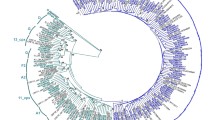Abstract
Sustained suppression of viral replication in HIV-1 infected patients is especially hampered by the emergence of HIV-1 drug resistance. The mechanisms of drug resistance mainly involve mutations directly altering the interaction of viral enzymes and inhibitors. However, protease inhibitors do not only select for mutations in the protease but also for mutations in the precursor Gag and Pol proteins. In this study, we analysed the frameshift-regulating site of HIV-1 subtype B isolates, which also encodes for Gag and Pol proteins, classified as either treatment-naïve (TN) or protease inhibitor resistant (PI-R). HIV-1 Gag cleavage site mutations (G435E, K436N, I437V, L449F/V) especially correlated with protease inhibitor resistance mutations, but also Pol cleavage site mutations (D05G, D05S) could be assigned to specific protease resistance profiles. Additionally, two Gag non-cleavage site mutations (S440F, H441P) were observed more often in HIV-1 isolates carrying protease resistance mutations. However, in dual luciferase assays, the frameshift efficiencies of specific clones did not reveal any effect from these mutations. Nevertheless, two patterns of mutations modestly increased the frameshift rates in vitro, but were not specifically accumulating in PI-resistant HIV-1 isolates. In summary, HIV-1 Gag cleavage site mutations were dominantly selected in PI-resistant HIV-1 isolates but also Pol cleavage site mutations influenced resistance profiles in the protease. Additionally, Gag non-cleavage site mutations accumulated in PI-resistant HIV-1 isolates, but were not related to an increased frameshift efficiency.

Similar content being viewed by others
References
Knops E, Kemper I, Schulter E, Pfister H, Kaiser R, Verheyen J (2010) The evolution of protease mutation 76V is associated with protease mutation 46I and gag mutation 431V. Aids 24(5):779–781. doi:10.1097/QAD.0b013e328336784d
Nijhuis M, van Maarseveen NM, Lastere S, Schipper P, Coakley E, Glass B, Rovenska M, de Jong D, Chappey C, Goedegebuure IW, Heilek-Snyder G, Dulude D, Cammack N, Brakier-Gingras L, Konvalinka J, Parkin N, Krausslich HG, Brun-Vezinet F, Boucher CA (2007) A novel substrate-based HIV-1 protease inhibitor drug resistance mechanism. PLoS Med 4(1):e36
Dam E, Quercia R, Glass B, Descamps D, Launay O, Duval X, Krausslich HG, Hance AJ, Clavel F (2009) Gag mutations strongly contribute to HIV-1 resistance to protease inhibitors in highly drug-experienced patients besides compensating for fitness loss. PLoS Pathog 5(3):e1000345. doi:10.1371/journal.ppat.1000345
Prabu-Jeyabalan M, Nalivaika EA, King NM, Schiffer CA (2004) Structural basis for coevolution of a human immunodeficiency virus type 1 nucleocapsid-p1 cleavage site with a V82A drug-resistant mutation in viral protease. J Virol 78(22):12446–12454
Ho SK, Coman RM, Bunger JC, Rose SL, O’Brien P, Munoz I, Dunn BM, Sleasman JW, Goodenow MM (2008) Drug-associated changes in amino acid residues in Gag p2, p7(NC), and p6(Gag)/p6(Pol) in human immunodeficiency virus type 1 (HIV-1) display a dominant effect on replicative fitness and drug response. Virology 378(2):272–281. doi:10.1016/j.virol.2008.05.029
Gupta RK, Kohli A, McCormick AL, Towers GJ, Pillay D, Parry CM (2010) Full-length HIV-1 Gag determines protease inhibitor susceptibility within in vitro assays. Aids 24(11):1651–1655
Knops E, Daumer M, Awerkiew S, Kartashev V, Schulter E, Kutsev S, Brakier-Gingras L, Kaiser R, Pfister H, Verheyen J (2010) Evolution of protease inhibitor resistance in the gag and pol genes of HIV subtype G isolates. J Antimicrob Chemother 65(7):1472–1476. doi:10.1093/jac/dkq129
Shehu-Xhilaga M, Crowe SM, Mak J (2001) Maintenance of the Gag/Gag-Pol ratio is important for human immunodeficiency virus type 1 RNA dimerization and viral infectivity. J Virol 75(4):1834–1841. doi:10.1128/JVI.75.4.1834-1841.2001
Callebaut C, Stray K, Tsai L, Xu L, Lee W, Cihlar T (2007) In vitro HIV-1 resistance selection to GS-8374, a novel phosphonate protease inhibitor: comparison with lopinavir, atazanavir and darunavir. In: XVI International HIV drug resistance workshop, Barbados, West Indies, 12–16 June 2007. Antiviral Therapy, Abstract 16, p S18
Verheyen J, Schweitzer F, Harrer EG, Knops E, Mueller SM, Daumer M, Eismann K, Bergmann S, Spriewald BM, Kaiser R, Harrer T (2010) Analysis of immune selection as a potential cause for the presence of cleavage site mutation 431V in treatment-naive HIV type-1 isolates. Antivir Ther 15(6):907–912. doi:10.3851/IMP1640
Larrouy L, Chazallon C, Landman R, Capitant C, Peytavin G, Collin G, Charpentier C, Storto A, Pialoux G, Katlama C, Girard PM, Yeni P, Aboulker JP, Brun-Vezinet F, Descamps D (2010) Gag mutations can impact virological response to dual-boosted protease inhibitor combinations in antiretroviral-naive HIV-infected patients. Antimicrob Agents Chemother 54(7):2910–2919. doi:10.1128/AAC.00194-10
Girnary R, King L, Robinson L, Elston R, Brierley I (2007) Structure-function analysis of the ribosomal frameshifting signal of two human immunodeficiency virus type 1 isolates with increased resistance to viral protease inhibitors. J Gen Virol 88(Pt 1):226–235
Doyon L, Payant C, Brakier-Gingras L, Lamarre D (1998) Novel Gag-Pol frameshift site in human immunodeficiency virus type 1 variants resistant to protease inhibitors. J Virol 72(7):6146–6150
Hill MK, Shehu-Xhilaga M, Crowe SM, Mak J (2002) Proline residues within spacer peptide p1 are important for human immunodeficiency virus type 1 infectivity, protein processing, and genomic RNA dimer stability. J Virol 76(22):11245–11253
Chiu HC, Wang FD, Chen YM, Wang CT (2006) Effects of human immunodeficiency virus type 1 transframe protein p6* mutations on viral protease-mediated Gag processing. J Gen Virol 87(Pt 7):2041–2046. doi:10.1099/vir.0.81601-0
Leiherer A, Ludwig C, Wagner R (2009) Uncoupling human immunodeficiency virus type 1 Gag and Pol reading frames: role of the transframe protein p6* in viral replication. J Virol 83(14):7210–7220. doi:10.1128/JVI.02603-08
Schulter E, Oette M, Balduin M, Reuter S, Rockstroh J, Fatkenheuer G, Esser S, Lengauer T, Agacfidan A, Pfister H, Kaiser R, Akgul B (2011) HIV prevalence and route of transmission in Turkish immigrants living in North-Rhine Westphalia, Germany. Med Microbiol Immunol 200:219–223. doi:10.1007/s00430-011-0193-2
Reuter S, Oette M, Wilhelm FC, Beggel B, Kaiser R, Balduin M, Schweitzer F, Verheyen J, Adams O, Lengauer T, Fatkenheuer G, Pfister H, Haussinger D (2011) Prevalence and characteristics of hepatitis B and C virus infections in treatment-naive HIV-infected patients. Med Microbiol Immunol 200(1):39–49. doi:10.1007/s00430-010-0172-z
Sierra S, Lubke N, Walter H, Schulter E, Reuter S, Fatkenheuer G, Bickel M, Silva HD, Kaiser R, Esser S (2011) The SnoB study: frequency of baseline raltegravir resistance mutations prevalence in different non-B subtypes. Med Microbiol Immunol 200:225–232. doi:10.1007/s00430-011-0194-1
Oette M, Kaiser R, Daumer M, Akbari D, Fatkenheuer G, Rockstroh JK, Stechel J, Rieke A, Mauss S, Schmaloer D, Gobels K, Vogt C, Wettstein M, Haussinger D (2004) Primary drug-resistance in HIV-positive patients on initiation of first-line antiretroviral therapy in Germany. Eur J Med Res 9(5):273–278
Verheyen J, Litau E, Sing T, Daumer M, Balduin M, Oette M, Fatkenheuer G, Rockstroh JK, Schuldenzucker U, Hoffmann D, Pfister H, Kaiser R (2006) Compensatory mutations at the HIV cleavage sites p7/p1 and p1/p6-gag in therapy-naive and therapy-experienced patients. Antivir Ther 11(7):879–887
Dulude D, Baril M, Brakier-Gingras L (2002) Characterization of the frameshift stimulatory signal controlling a programmed-1 ribosomal frameshift in the human immunodeficiency virus type 1. Nucleic Acids Res 30(23):5094–5102
Dulude D, Berchiche YA, Gendron K, Brakier-Gingras L, Heveker N (2006) Decreasing the frameshift efficiency translates into an equivalent reduction of the replication of the human immunodeficiency virus type 1. Virology 345(1):127–136. doi:10.1016/j.virol.2005.08.048
Grentzmann G, Ingram JA, Kelly PJ, Gesteland RF, Atkins JF (1998) A dual-luciferase reporter system for studying recoding signals. RNA 4(4):479–486
Verheyen J, Knops E, Kupfer B, Hamouda O, Somogyi S, Schuldenzucker U, Hoffmann D, Kaiser R, Pfister H, Kucherer C (2009) Prevalence of C-terminal gag cleavage site mutations in HIV from therapy-naive patients. J Infect 58(1):61–67. doi:10.1016/j.jinf.2008.11.009
van Maarseveen NM, Wensing AM, de Jong D, Taconis M, Borleffs JC, Boucher CA, Nijhuis M (2007) Persistence of HIV-1 variants with multiple protease inhibitor (PI)-resistance mutations in the absence of PI therapy can be explained by compensatory fixation. J Infect Dis 195(3):399–409
Telenti A, Martinez R, Munoz M, Bleiber G, Greub G, Sanglard D, Peters S (2002) Analysis of natural variants of the human immunodeficiency virus type 1 gag-pol frameshift stem-loop structure. J Virol 76(15):7868–7873
Verheyen J, Verhofstede C, Knops E, Vandekerckhove L, Fun A, Brunen D, Dauwe K, Wensing AM, Pfister H, Kaiser R, Nijhuis M (2010) High prevalence of bevirimat resistance mutations in protease inhibitor-resistant HIV isolates. Aids 24(5):669–673. doi:10.1097/QAD.0b013e32833160fa
Heider D, Verheyen J, Hoffmann D (2010) Predicting Bevirimat resistance of HIV-1 from genotype. BMC Bioinformatics 11:37. doi:10.1186/1471-2105-11-37
Acknowledgments
This study was supported by the Koeln Fortune Program and the German Ministry of Health and Social Security (grand no. AZ 319-4476-02/3).
Author information
Authors and Affiliations
Corresponding author
Rights and permissions
About this article
Cite this article
Knops, E., Brakier-Gingras, L., Schülter, E. et al. Mutational patterns in the frameshift-regulating site of HIV-1 selected by protease inhibitors. Med Microbiol Immunol 201, 213–218 (2012). https://doi.org/10.1007/s00430-011-0224-z
Received:
Published:
Issue Date:
DOI: https://doi.org/10.1007/s00430-011-0224-z




